Facilities Operations Management Report: Evaluation & Systems Analysis
VerifiedAdded on 2020/02/12
|14
|4991
|34
Report
AI Summary
This report on facilities operations management comprehensively addresses the multifaceted responsibilities of a facilities manager, encompassing staff, operational aspects, and customer interactions. It delves into UK statutory regulations impacting facilities, emphasizing health, safety, and environmental measures, along with required documentation for compliance. The report further explores effective systems for information processing, communication, and control, essential for efficient facilities operations. Finally, it establishes criteria for evaluating the quality and effectiveness of these operations, reviewing procedures for analysis. The report provides a detailed overview of the key elements of facilities operations management and the strategic importance of it.
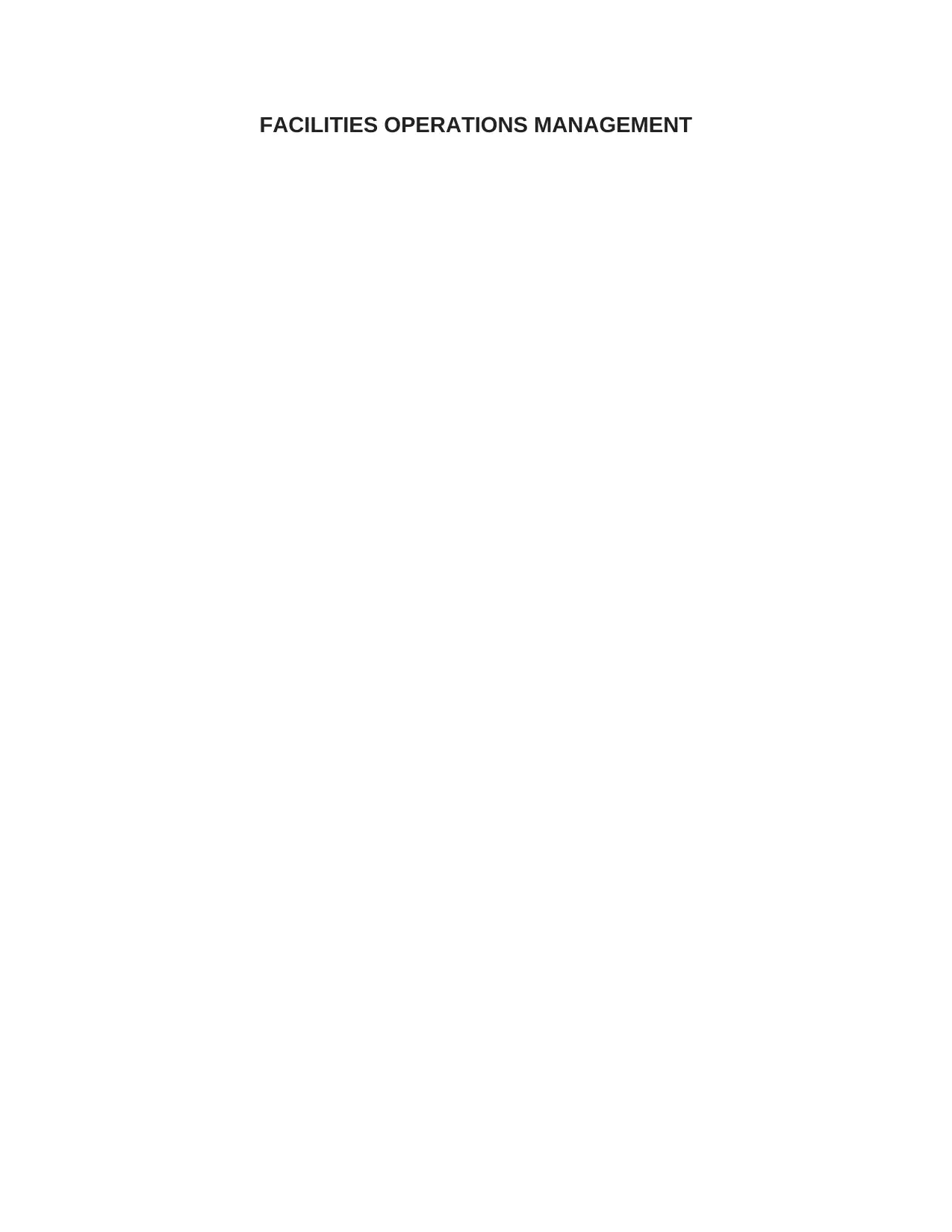
FACILITIES OPERATIONS MANAGEMENT
Secure Best Marks with AI Grader
Need help grading? Try our AI Grader for instant feedback on your assignments.
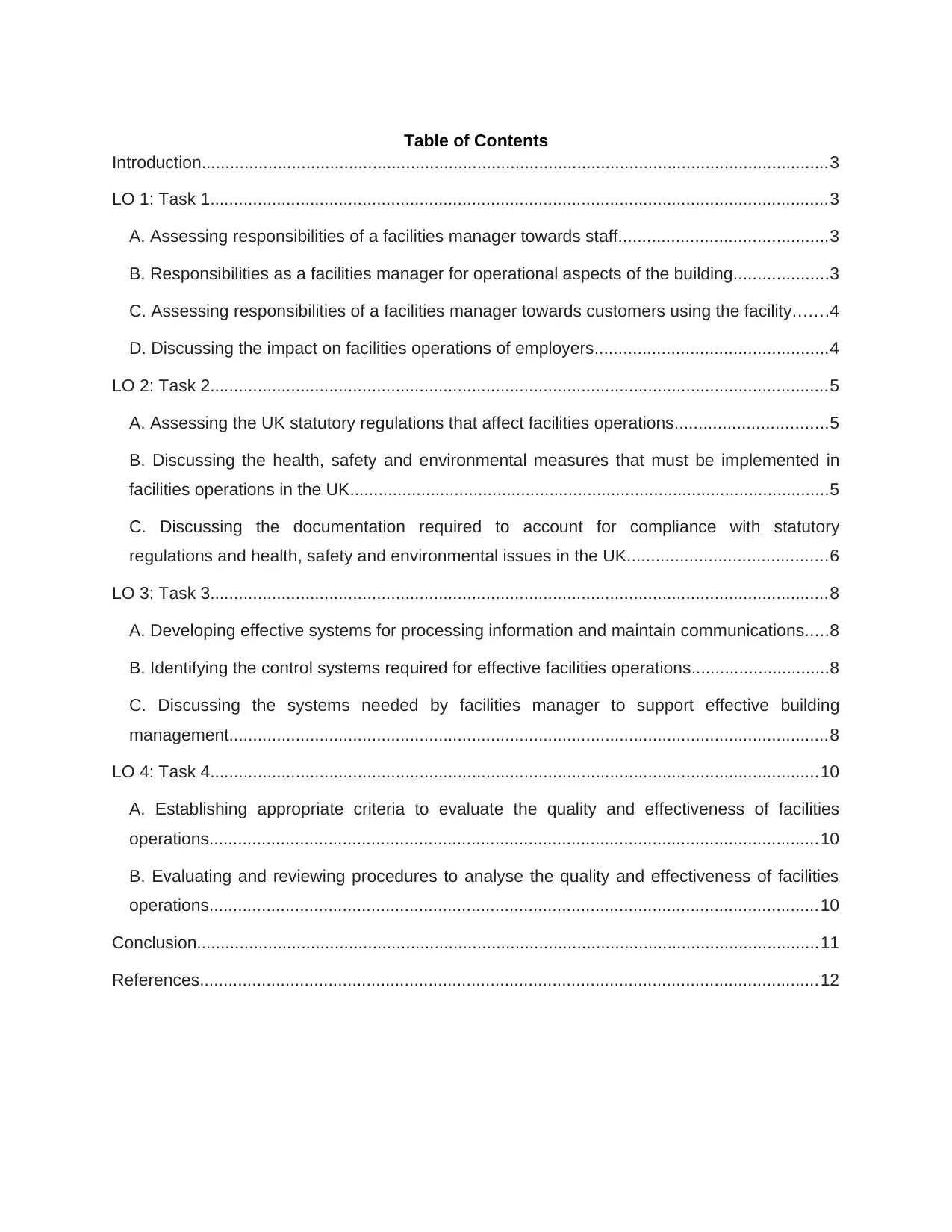
Table of Contents
Introduction....................................................................................................................................3
LO 1: Task 1..................................................................................................................................3
A. Assessing responsibilities of a facilities manager towards staff............................................3
B. Responsibilities as a facilities manager for operational aspects of the building....................3
C. Assessing responsibilities of a facilities manager towards customers using the facility.......4
D. Discussing the impact on facilities operations of employers.................................................4
LO 2: Task 2..................................................................................................................................5
A. Assessing the UK statutory regulations that affect facilities operations................................5
B. Discussing the health, safety and environmental measures that must be implemented in
facilities operations in the UK.....................................................................................................5
C. Discussing the documentation required to account for compliance with statutory
regulations and health, safety and environmental issues in the UK..........................................6
LO 3: Task 3..................................................................................................................................8
A. Developing effective systems for processing information and maintain communications.....8
B. Identifying the control systems required for effective facilities operations.............................8
C. Discussing the systems needed by facilities manager to support effective building
management..............................................................................................................................8
LO 4: Task 4................................................................................................................................10
A. Establishing appropriate criteria to evaluate the quality and effectiveness of facilities
operations................................................................................................................................10
B. Evaluating and reviewing procedures to analyse the quality and effectiveness of facilities
operations................................................................................................................................10
Conclusion...................................................................................................................................11
References..................................................................................................................................12
Introduction....................................................................................................................................3
LO 1: Task 1..................................................................................................................................3
A. Assessing responsibilities of a facilities manager towards staff............................................3
B. Responsibilities as a facilities manager for operational aspects of the building....................3
C. Assessing responsibilities of a facilities manager towards customers using the facility.......4
D. Discussing the impact on facilities operations of employers.................................................4
LO 2: Task 2..................................................................................................................................5
A. Assessing the UK statutory regulations that affect facilities operations................................5
B. Discussing the health, safety and environmental measures that must be implemented in
facilities operations in the UK.....................................................................................................5
C. Discussing the documentation required to account for compliance with statutory
regulations and health, safety and environmental issues in the UK..........................................6
LO 3: Task 3..................................................................................................................................8
A. Developing effective systems for processing information and maintain communications.....8
B. Identifying the control systems required for effective facilities operations.............................8
C. Discussing the systems needed by facilities manager to support effective building
management..............................................................................................................................8
LO 4: Task 4................................................................................................................................10
A. Establishing appropriate criteria to evaluate the quality and effectiveness of facilities
operations................................................................................................................................10
B. Evaluating and reviewing procedures to analyse the quality and effectiveness of facilities
operations................................................................................................................................10
Conclusion...................................................................................................................................11
References..................................................................................................................................12
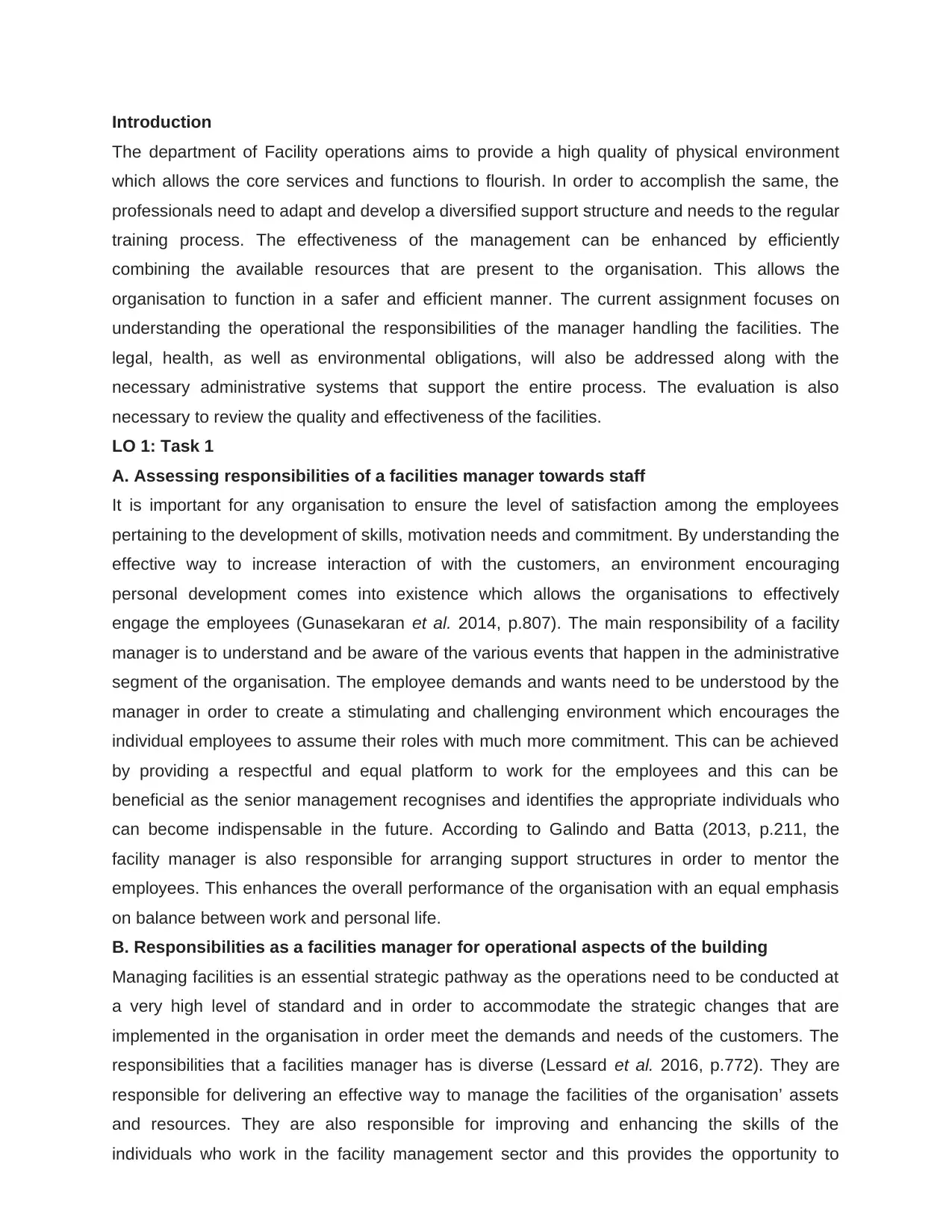
Introduction
The department of Facility operations aims to provide a high quality of physical environment
which allows the core services and functions to flourish. In order to accomplish the same, the
professionals need to adapt and develop a diversified support structure and needs to the regular
training process. The effectiveness of the management can be enhanced by efficiently
combining the available resources that are present to the organisation. This allows the
organisation to function in a safer and efficient manner. The current assignment focuses on
understanding the operational the responsibilities of the manager handling the facilities. The
legal, health, as well as environmental obligations, will also be addressed along with the
necessary administrative systems that support the entire process. The evaluation is also
necessary to review the quality and effectiveness of the facilities.
LO 1: Task 1
A. Assessing responsibilities of a facilities manager towards staff
It is important for any organisation to ensure the level of satisfaction among the employees
pertaining to the development of skills, motivation needs and commitment. By understanding the
effective way to increase interaction of with the customers, an environment encouraging
personal development comes into existence which allows the organisations to effectively
engage the employees (Gunasekaran et al. 2014, p.807). The main responsibility of a facility
manager is to understand and be aware of the various events that happen in the administrative
segment of the organisation. The employee demands and wants need to be understood by the
manager in order to create a stimulating and challenging environment which encourages the
individual employees to assume their roles with much more commitment. This can be achieved
by providing a respectful and equal platform to work for the employees and this can be
beneficial as the senior management recognises and identifies the appropriate individuals who
can become indispensable in the future. According to Galindo and Batta (2013, p.211, the
facility manager is also responsible for arranging support structures in order to mentor the
employees. This enhances the overall performance of the organisation with an equal emphasis
on balance between work and personal life.
B. Responsibilities as a facilities manager for operational aspects of the building
Managing facilities is an essential strategic pathway as the operations need to be conducted at
a very high level of standard and in order to accommodate the strategic changes that are
implemented in the organisation in order meet the demands and needs of the customers. The
responsibilities that a facilities manager has is diverse (Lessard et al. 2016, p.772). They are
responsible for delivering an effective way to manage the facilities of the organisation’ assets
and resources. They are also responsible for improving and enhancing the skills of the
individuals who work in the facility management sector and this provides the opportunity to
The department of Facility operations aims to provide a high quality of physical environment
which allows the core services and functions to flourish. In order to accomplish the same, the
professionals need to adapt and develop a diversified support structure and needs to the regular
training process. The effectiveness of the management can be enhanced by efficiently
combining the available resources that are present to the organisation. This allows the
organisation to function in a safer and efficient manner. The current assignment focuses on
understanding the operational the responsibilities of the manager handling the facilities. The
legal, health, as well as environmental obligations, will also be addressed along with the
necessary administrative systems that support the entire process. The evaluation is also
necessary to review the quality and effectiveness of the facilities.
LO 1: Task 1
A. Assessing responsibilities of a facilities manager towards staff
It is important for any organisation to ensure the level of satisfaction among the employees
pertaining to the development of skills, motivation needs and commitment. By understanding the
effective way to increase interaction of with the customers, an environment encouraging
personal development comes into existence which allows the organisations to effectively
engage the employees (Gunasekaran et al. 2014, p.807). The main responsibility of a facility
manager is to understand and be aware of the various events that happen in the administrative
segment of the organisation. The employee demands and wants need to be understood by the
manager in order to create a stimulating and challenging environment which encourages the
individual employees to assume their roles with much more commitment. This can be achieved
by providing a respectful and equal platform to work for the employees and this can be
beneficial as the senior management recognises and identifies the appropriate individuals who
can become indispensable in the future. According to Galindo and Batta (2013, p.211, the
facility manager is also responsible for arranging support structures in order to mentor the
employees. This enhances the overall performance of the organisation with an equal emphasis
on balance between work and personal life.
B. Responsibilities as a facilities manager for operational aspects of the building
Managing facilities is an essential strategic pathway as the operations need to be conducted at
a very high level of standard and in order to accommodate the strategic changes that are
implemented in the organisation in order meet the demands and needs of the customers. The
responsibilities that a facilities manager has is diverse (Lessard et al. 2016, p.772). They are
responsible for delivering an effective way to manage the facilities of the organisation’ assets
and resources. They are also responsible for improving and enhancing the skills of the
individuals who work in the facility management sector and this provides the opportunity to
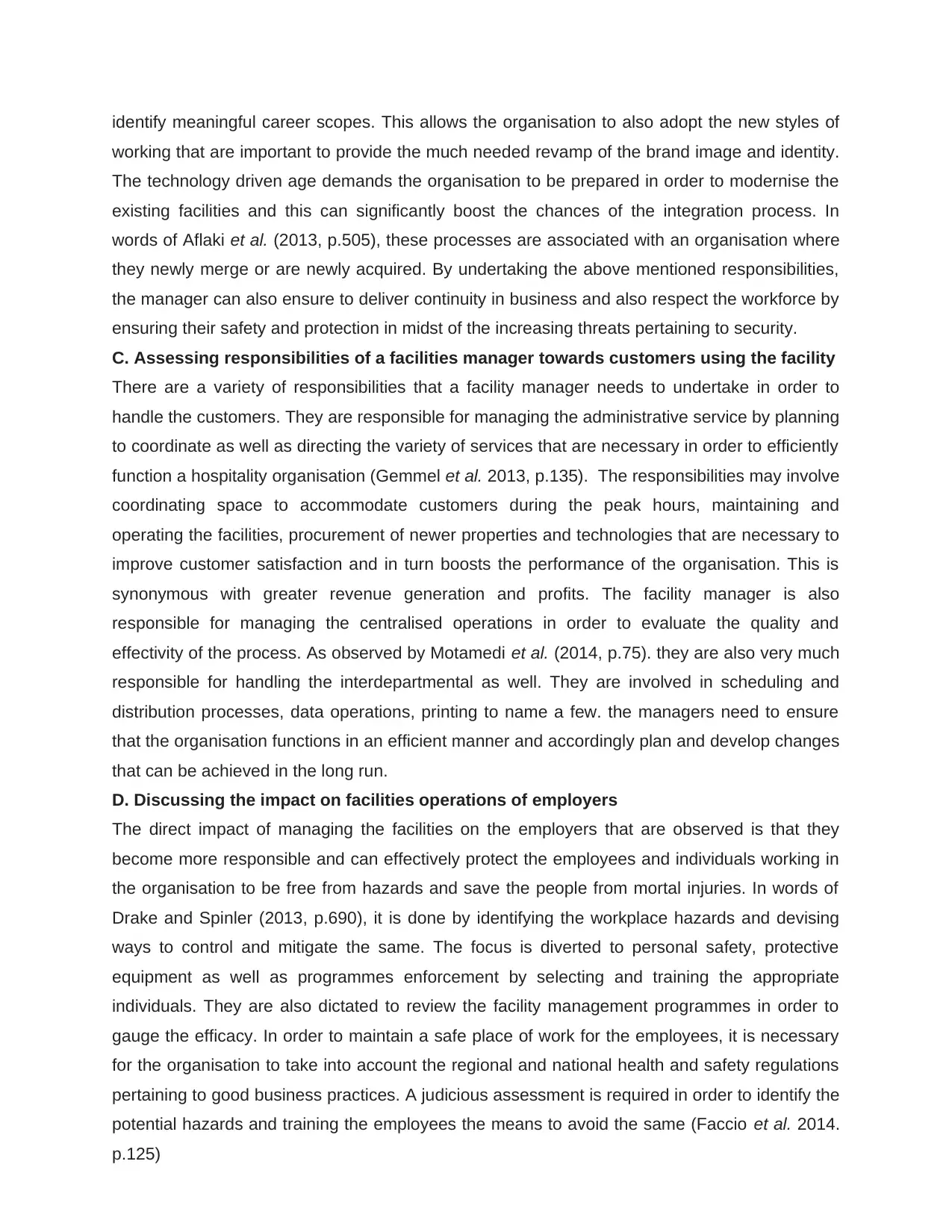
identify meaningful career scopes. This allows the organisation to also adopt the new styles of
working that are important to provide the much needed revamp of the brand image and identity.
The technology driven age demands the organisation to be prepared in order to modernise the
existing facilities and this can significantly boost the chances of the integration process. In
words of Aflaki et al. (2013, p.505), these processes are associated with an organisation where
they newly merge or are newly acquired. By undertaking the above mentioned responsibilities,
the manager can also ensure to deliver continuity in business and also respect the workforce by
ensuring their safety and protection in midst of the increasing threats pertaining to security.
C. Assessing responsibilities of a facilities manager towards customers using the facility
There are a variety of responsibilities that a facility manager needs to undertake in order to
handle the customers. They are responsible for managing the administrative service by planning
to coordinate as well as directing the variety of services that are necessary in order to efficiently
function a hospitality organisation (Gemmel et al. 2013, p.135). The responsibilities may involve
coordinating space to accommodate customers during the peak hours, maintaining and
operating the facilities, procurement of newer properties and technologies that are necessary to
improve customer satisfaction and in turn boosts the performance of the organisation. This is
synonymous with greater revenue generation and profits. The facility manager is also
responsible for managing the centralised operations in order to evaluate the quality and
effectivity of the process. As observed by Motamedi et al. (2014, p.75). they are also very much
responsible for handling the interdepartmental as well. They are involved in scheduling and
distribution processes, data operations, printing to name a few. the managers need to ensure
that the organisation functions in an efficient manner and accordingly plan and develop changes
that can be achieved in the long run.
D. Discussing the impact on facilities operations of employers
The direct impact of managing the facilities on the employers that are observed is that they
become more responsible and can effectively protect the employees and individuals working in
the organisation to be free from hazards and save the people from mortal injuries. In words of
Drake and Spinler (2013, p.690), it is done by identifying the workplace hazards and devising
ways to control and mitigate the same. The focus is diverted to personal safety, protective
equipment as well as programmes enforcement by selecting and training the appropriate
individuals. They are also dictated to review the facility management programmes in order to
gauge the efficacy. In order to maintain a safe place of work for the employees, it is necessary
for the organisation to take into account the regional and national health and safety regulations
pertaining to good business practices. A judicious assessment is required in order to identify the
potential hazards and training the employees the means to avoid the same (Faccio et al. 2014.
p.125)
working that are important to provide the much needed revamp of the brand image and identity.
The technology driven age demands the organisation to be prepared in order to modernise the
existing facilities and this can significantly boost the chances of the integration process. In
words of Aflaki et al. (2013, p.505), these processes are associated with an organisation where
they newly merge or are newly acquired. By undertaking the above mentioned responsibilities,
the manager can also ensure to deliver continuity in business and also respect the workforce by
ensuring their safety and protection in midst of the increasing threats pertaining to security.
C. Assessing responsibilities of a facilities manager towards customers using the facility
There are a variety of responsibilities that a facility manager needs to undertake in order to
handle the customers. They are responsible for managing the administrative service by planning
to coordinate as well as directing the variety of services that are necessary in order to efficiently
function a hospitality organisation (Gemmel et al. 2013, p.135). The responsibilities may involve
coordinating space to accommodate customers during the peak hours, maintaining and
operating the facilities, procurement of newer properties and technologies that are necessary to
improve customer satisfaction and in turn boosts the performance of the organisation. This is
synonymous with greater revenue generation and profits. The facility manager is also
responsible for managing the centralised operations in order to evaluate the quality and
effectivity of the process. As observed by Motamedi et al. (2014, p.75). they are also very much
responsible for handling the interdepartmental as well. They are involved in scheduling and
distribution processes, data operations, printing to name a few. the managers need to ensure
that the organisation functions in an efficient manner and accordingly plan and develop changes
that can be achieved in the long run.
D. Discussing the impact on facilities operations of employers
The direct impact of managing the facilities on the employers that are observed is that they
become more responsible and can effectively protect the employees and individuals working in
the organisation to be free from hazards and save the people from mortal injuries. In words of
Drake and Spinler (2013, p.690), it is done by identifying the workplace hazards and devising
ways to control and mitigate the same. The focus is diverted to personal safety, protective
equipment as well as programmes enforcement by selecting and training the appropriate
individuals. They are also dictated to review the facility management programmes in order to
gauge the efficacy. In order to maintain a safe place of work for the employees, it is necessary
for the organisation to take into account the regional and national health and safety regulations
pertaining to good business practices. A judicious assessment is required in order to identify the
potential hazards and training the employees the means to avoid the same (Faccio et al. 2014.
p.125)
Secure Best Marks with AI Grader
Need help grading? Try our AI Grader for instant feedback on your assignments.
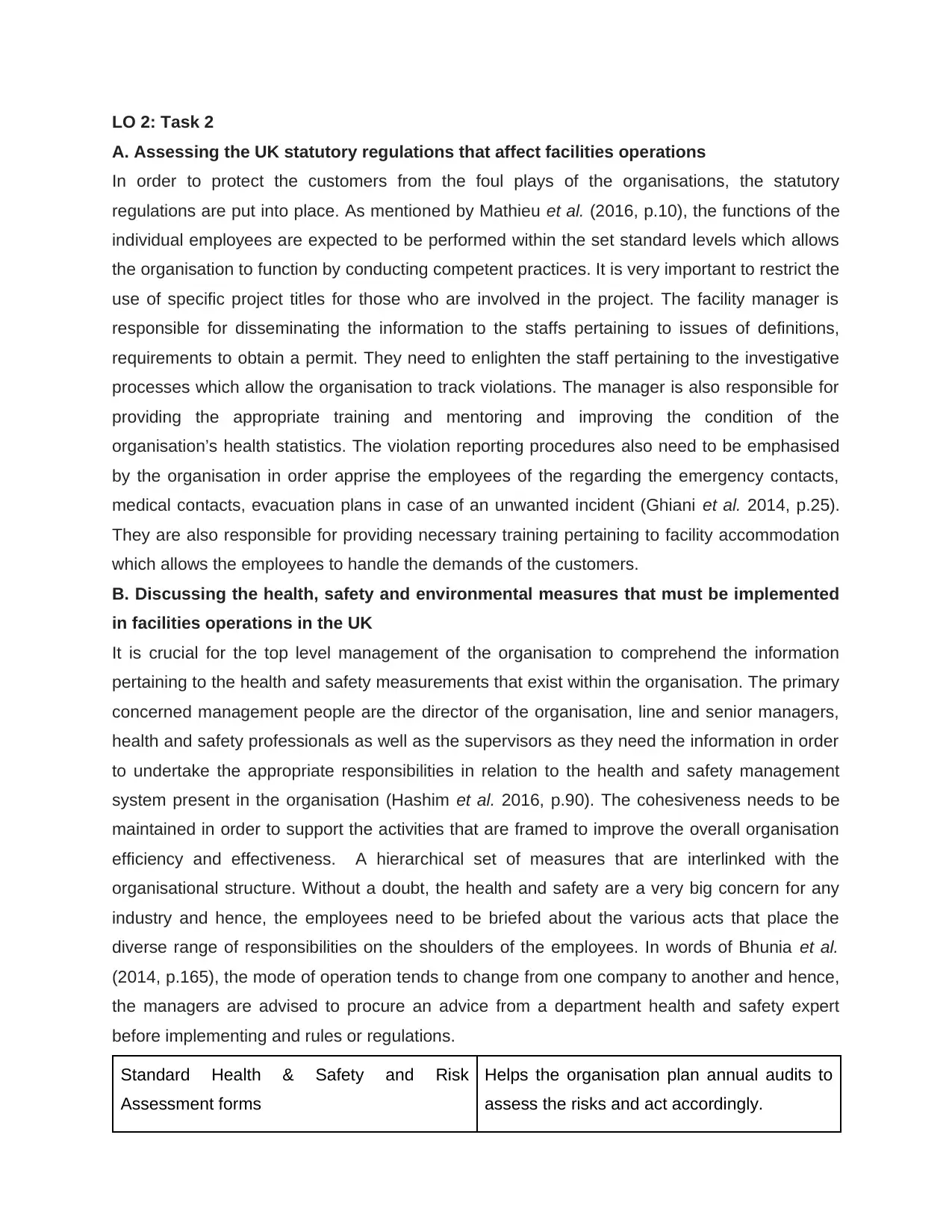
LO 2: Task 2
A. Assessing the UK statutory regulations that affect facilities operations
In order to protect the customers from the foul plays of the organisations, the statutory
regulations are put into place. As mentioned by Mathieu et al. (2016, p.10), the functions of the
individual employees are expected to be performed within the set standard levels which allows
the organisation to function by conducting competent practices. It is very important to restrict the
use of specific project titles for those who are involved in the project. The facility manager is
responsible for disseminating the information to the staffs pertaining to issues of definitions,
requirements to obtain a permit. They need to enlighten the staff pertaining to the investigative
processes which allow the organisation to track violations. The manager is also responsible for
providing the appropriate training and mentoring and improving the condition of the
organisation’s health statistics. The violation reporting procedures also need to be emphasised
by the organisation in order apprise the employees of the regarding the emergency contacts,
medical contacts, evacuation plans in case of an unwanted incident (Ghiani et al. 2014, p.25).
They are also responsible for providing necessary training pertaining to facility accommodation
which allows the employees to handle the demands of the customers.
B. Discussing the health, safety and environmental measures that must be implemented
in facilities operations in the UK
It is crucial for the top level management of the organisation to comprehend the information
pertaining to the health and safety measurements that exist within the organisation. The primary
concerned management people are the director of the organisation, line and senior managers,
health and safety professionals as well as the supervisors as they need the information in order
to undertake the appropriate responsibilities in relation to the health and safety management
system present in the organisation (Hashim et al. 2016, p.90). The cohesiveness needs to be
maintained in order to support the activities that are framed to improve the overall organisation
efficiency and effectiveness. A hierarchical set of measures that are interlinked with the
organisational structure. Without a doubt, the health and safety are a very big concern for any
industry and hence, the employees need to be briefed about the various acts that place the
diverse range of responsibilities on the shoulders of the employees. In words of Bhunia et al.
(2014, p.165), the mode of operation tends to change from one company to another and hence,
the managers are advised to procure an advice from a department health and safety expert
before implementing and rules or regulations.
Standard Health & Safety and Risk
Assessment forms
Helps the organisation plan annual audits to
assess the risks and act accordingly.
A. Assessing the UK statutory regulations that affect facilities operations
In order to protect the customers from the foul plays of the organisations, the statutory
regulations are put into place. As mentioned by Mathieu et al. (2016, p.10), the functions of the
individual employees are expected to be performed within the set standard levels which allows
the organisation to function by conducting competent practices. It is very important to restrict the
use of specific project titles for those who are involved in the project. The facility manager is
responsible for disseminating the information to the staffs pertaining to issues of definitions,
requirements to obtain a permit. They need to enlighten the staff pertaining to the investigative
processes which allow the organisation to track violations. The manager is also responsible for
providing the appropriate training and mentoring and improving the condition of the
organisation’s health statistics. The violation reporting procedures also need to be emphasised
by the organisation in order apprise the employees of the regarding the emergency contacts,
medical contacts, evacuation plans in case of an unwanted incident (Ghiani et al. 2014, p.25).
They are also responsible for providing necessary training pertaining to facility accommodation
which allows the employees to handle the demands of the customers.
B. Discussing the health, safety and environmental measures that must be implemented
in facilities operations in the UK
It is crucial for the top level management of the organisation to comprehend the information
pertaining to the health and safety measurements that exist within the organisation. The primary
concerned management people are the director of the organisation, line and senior managers,
health and safety professionals as well as the supervisors as they need the information in order
to undertake the appropriate responsibilities in relation to the health and safety management
system present in the organisation (Hashim et al. 2016, p.90). The cohesiveness needs to be
maintained in order to support the activities that are framed to improve the overall organisation
efficiency and effectiveness. A hierarchical set of measures that are interlinked with the
organisational structure. Without a doubt, the health and safety are a very big concern for any
industry and hence, the employees need to be briefed about the various acts that place the
diverse range of responsibilities on the shoulders of the employees. In words of Bhunia et al.
(2014, p.165), the mode of operation tends to change from one company to another and hence,
the managers are advised to procure an advice from a department health and safety expert
before implementing and rules or regulations.
Standard Health & Safety and Risk
Assessment forms
Helps the organisation plan annual audits to
assess the risks and act accordingly.
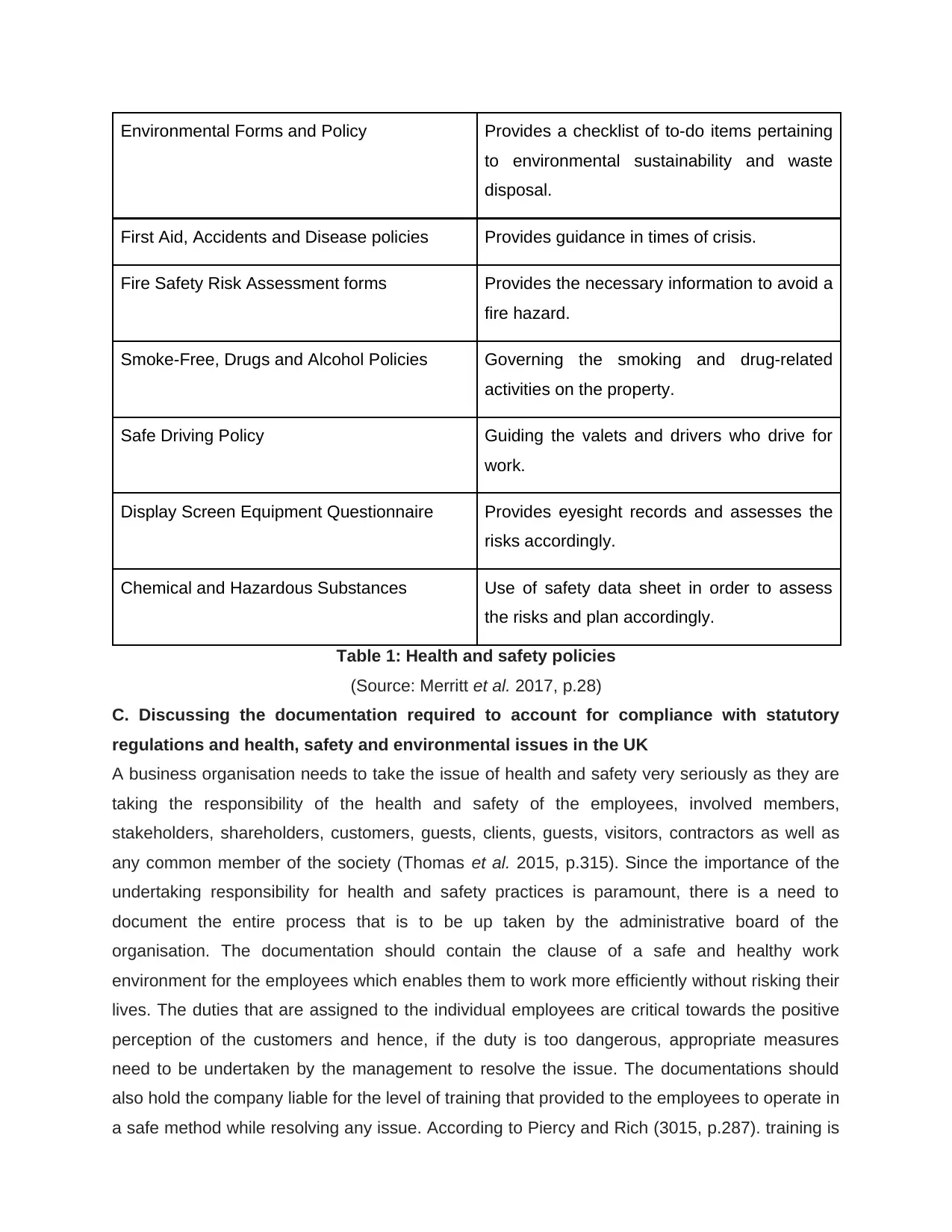
Environmental Forms and Policy Provides a checklist of to-do items pertaining
to environmental sustainability and waste
disposal.
First Aid, Accidents and Disease policies Provides guidance in times of crisis.
Fire Safety Risk Assessment forms Provides the necessary information to avoid a
fire hazard.
Smoke-Free, Drugs and Alcohol Policies Governing the smoking and drug-related
activities on the property.
Safe Driving Policy Guiding the valets and drivers who drive for
work.
Display Screen Equipment Questionnaire Provides eyesight records and assesses the
risks accordingly.
Chemical and Hazardous Substances Use of safety data sheet in order to assess
the risks and plan accordingly.
Table 1: Health and safety policies
(Source: Merritt et al. 2017, p.28)
C. Discussing the documentation required to account for compliance with statutory
regulations and health, safety and environmental issues in the UK
A business organisation needs to take the issue of health and safety very seriously as they are
taking the responsibility of the health and safety of the employees, involved members,
stakeholders, shareholders, customers, guests, clients, guests, visitors, contractors as well as
any common member of the society (Thomas et al. 2015, p.315). Since the importance of the
undertaking responsibility for health and safety practices is paramount, there is a need to
document the entire process that is to be up taken by the administrative board of the
organisation. The documentation should contain the clause of a safe and healthy work
environment for the employees which enables them to work more efficiently without risking their
lives. The duties that are assigned to the individual employees are critical towards the positive
perception of the customers and hence, if the duty is too dangerous, appropriate measures
need to be undertaken by the management to resolve the issue. The documentations should
also hold the company liable for the level of training that provided to the employees to operate in
a safe method while resolving any issue. According to Piercy and Rich (3015, p.287). training is
to environmental sustainability and waste
disposal.
First Aid, Accidents and Disease policies Provides guidance in times of crisis.
Fire Safety Risk Assessment forms Provides the necessary information to avoid a
fire hazard.
Smoke-Free, Drugs and Alcohol Policies Governing the smoking and drug-related
activities on the property.
Safe Driving Policy Guiding the valets and drivers who drive for
work.
Display Screen Equipment Questionnaire Provides eyesight records and assesses the
risks accordingly.
Chemical and Hazardous Substances Use of safety data sheet in order to assess
the risks and plan accordingly.
Table 1: Health and safety policies
(Source: Merritt et al. 2017, p.28)
C. Discussing the documentation required to account for compliance with statutory
regulations and health, safety and environmental issues in the UK
A business organisation needs to take the issue of health and safety very seriously as they are
taking the responsibility of the health and safety of the employees, involved members,
stakeholders, shareholders, customers, guests, clients, guests, visitors, contractors as well as
any common member of the society (Thomas et al. 2015, p.315). Since the importance of the
undertaking responsibility for health and safety practices is paramount, there is a need to
document the entire process that is to be up taken by the administrative board of the
organisation. The documentation should contain the clause of a safe and healthy work
environment for the employees which enables them to work more efficiently without risking their
lives. The duties that are assigned to the individual employees are critical towards the positive
perception of the customers and hence, if the duty is too dangerous, appropriate measures
need to be undertaken by the management to resolve the issue. The documentations should
also hold the company liable for the level of training that provided to the employees to operate in
a safe method while resolving any issue. According to Piercy and Rich (3015, p.287). training is
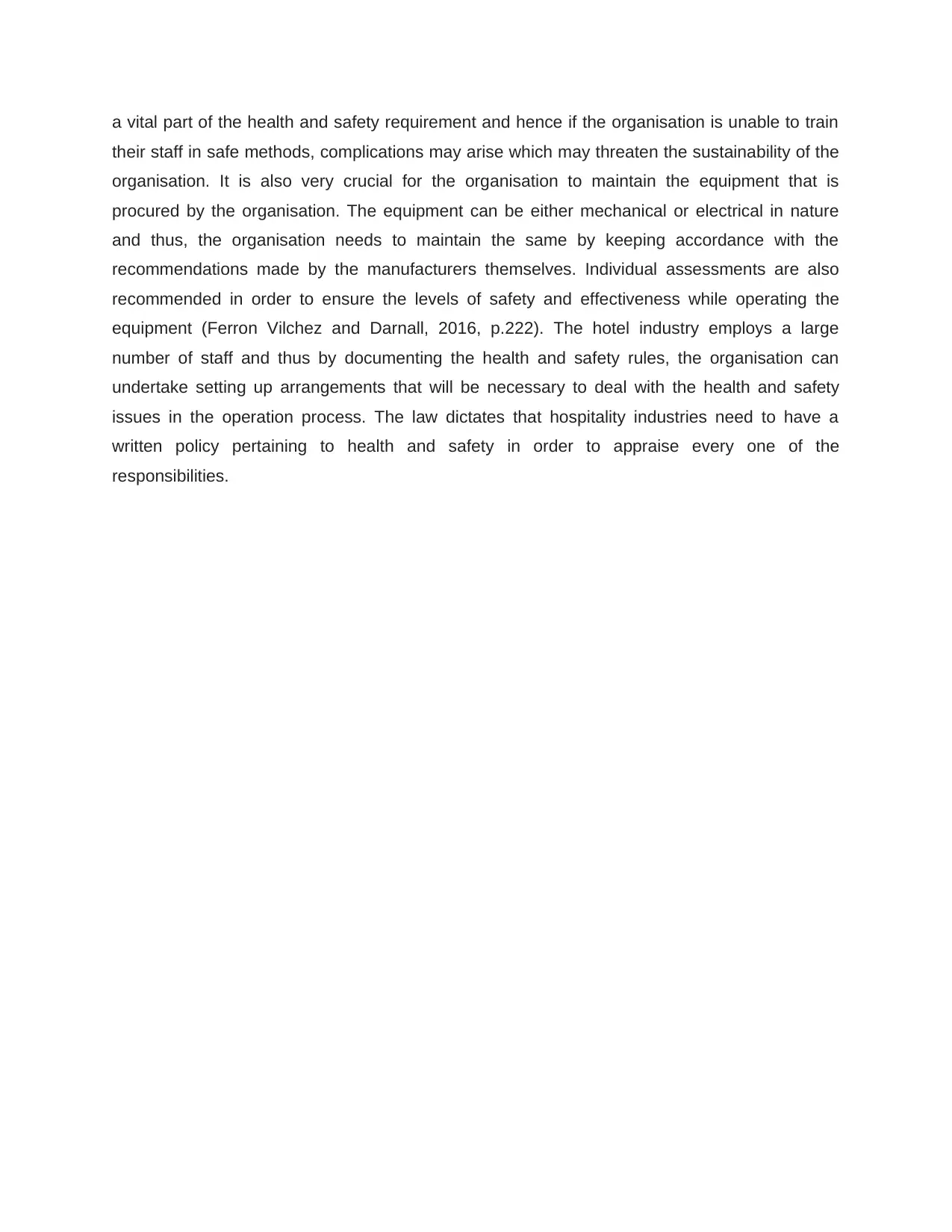
a vital part of the health and safety requirement and hence if the organisation is unable to train
their staff in safe methods, complications may arise which may threaten the sustainability of the
organisation. It is also very crucial for the organisation to maintain the equipment that is
procured by the organisation. The equipment can be either mechanical or electrical in nature
and thus, the organisation needs to maintain the same by keeping accordance with the
recommendations made by the manufacturers themselves. Individual assessments are also
recommended in order to ensure the levels of safety and effectiveness while operating the
equipment (Ferron Vilchez and Darnall, 2016, p.222). The hotel industry employs a large
number of staff and thus by documenting the health and safety rules, the organisation can
undertake setting up arrangements that will be necessary to deal with the health and safety
issues in the operation process. The law dictates that hospitality industries need to have a
written policy pertaining to health and safety in order to appraise every one of the
responsibilities.
their staff in safe methods, complications may arise which may threaten the sustainability of the
organisation. It is also very crucial for the organisation to maintain the equipment that is
procured by the organisation. The equipment can be either mechanical or electrical in nature
and thus, the organisation needs to maintain the same by keeping accordance with the
recommendations made by the manufacturers themselves. Individual assessments are also
recommended in order to ensure the levels of safety and effectiveness while operating the
equipment (Ferron Vilchez and Darnall, 2016, p.222). The hotel industry employs a large
number of staff and thus by documenting the health and safety rules, the organisation can
undertake setting up arrangements that will be necessary to deal with the health and safety
issues in the operation process. The law dictates that hospitality industries need to have a
written policy pertaining to health and safety in order to appraise every one of the
responsibilities.
Paraphrase This Document
Need a fresh take? Get an instant paraphrase of this document with our AI Paraphraser
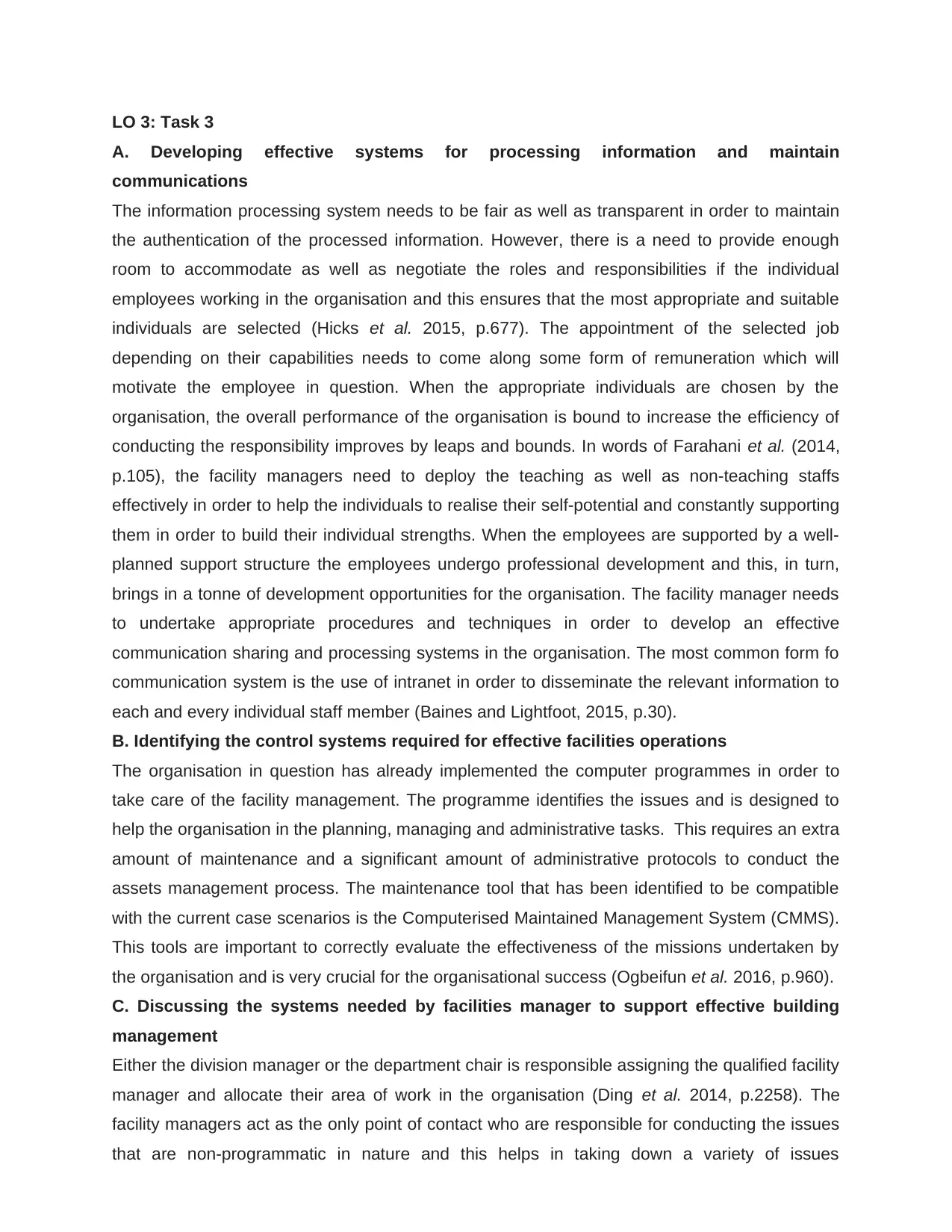
LO 3: Task 3
A. Developing effective systems for processing information and maintain
communications
The information processing system needs to be fair as well as transparent in order to maintain
the authentication of the processed information. However, there is a need to provide enough
room to accommodate as well as negotiate the roles and responsibilities if the individual
employees working in the organisation and this ensures that the most appropriate and suitable
individuals are selected (Hicks et al. 2015, p.677). The appointment of the selected job
depending on their capabilities needs to come along some form of remuneration which will
motivate the employee in question. When the appropriate individuals are chosen by the
organisation, the overall performance of the organisation is bound to increase the efficiency of
conducting the responsibility improves by leaps and bounds. In words of Farahani et al. (2014,
p.105), the facility managers need to deploy the teaching as well as non-teaching staffs
effectively in order to help the individuals to realise their self-potential and constantly supporting
them in order to build their individual strengths. When the employees are supported by a well-
planned support structure the employees undergo professional development and this, in turn,
brings in a tonne of development opportunities for the organisation. The facility manager needs
to undertake appropriate procedures and techniques in order to develop an effective
communication sharing and processing systems in the organisation. The most common form fo
communication system is the use of intranet in order to disseminate the relevant information to
each and every individual staff member (Baines and Lightfoot, 2015, p.30).
B. Identifying the control systems required for effective facilities operations
The organisation in question has already implemented the computer programmes in order to
take care of the facility management. The programme identifies the issues and is designed to
help the organisation in the planning, managing and administrative tasks. This requires an extra
amount of maintenance and a significant amount of administrative protocols to conduct the
assets management process. The maintenance tool that has been identified to be compatible
with the current case scenarios is the Computerised Maintained Management System (CMMS).
This tools are important to correctly evaluate the effectiveness of the missions undertaken by
the organisation and is very crucial for the organisational success (Ogbeifun et al. 2016, p.960).
C. Discussing the systems needed by facilities manager to support effective building
management
Either the division manager or the department chair is responsible assigning the qualified facility
manager and allocate their area of work in the organisation (Ding et al. 2014, p.2258). The
facility managers act as the only point of contact who are responsible for conducting the issues
that are non-programmatic in nature and this helps in taking down a variety of issues
A. Developing effective systems for processing information and maintain
communications
The information processing system needs to be fair as well as transparent in order to maintain
the authentication of the processed information. However, there is a need to provide enough
room to accommodate as well as negotiate the roles and responsibilities if the individual
employees working in the organisation and this ensures that the most appropriate and suitable
individuals are selected (Hicks et al. 2015, p.677). The appointment of the selected job
depending on their capabilities needs to come along some form of remuneration which will
motivate the employee in question. When the appropriate individuals are chosen by the
organisation, the overall performance of the organisation is bound to increase the efficiency of
conducting the responsibility improves by leaps and bounds. In words of Farahani et al. (2014,
p.105), the facility managers need to deploy the teaching as well as non-teaching staffs
effectively in order to help the individuals to realise their self-potential and constantly supporting
them in order to build their individual strengths. When the employees are supported by a well-
planned support structure the employees undergo professional development and this, in turn,
brings in a tonne of development opportunities for the organisation. The facility manager needs
to undertake appropriate procedures and techniques in order to develop an effective
communication sharing and processing systems in the organisation. The most common form fo
communication system is the use of intranet in order to disseminate the relevant information to
each and every individual staff member (Baines and Lightfoot, 2015, p.30).
B. Identifying the control systems required for effective facilities operations
The organisation in question has already implemented the computer programmes in order to
take care of the facility management. The programme identifies the issues and is designed to
help the organisation in the planning, managing and administrative tasks. This requires an extra
amount of maintenance and a significant amount of administrative protocols to conduct the
assets management process. The maintenance tool that has been identified to be compatible
with the current case scenarios is the Computerised Maintained Management System (CMMS).
This tools are important to correctly evaluate the effectiveness of the missions undertaken by
the organisation and is very crucial for the organisational success (Ogbeifun et al. 2016, p.960).
C. Discussing the systems needed by facilities manager to support effective building
management
Either the division manager or the department chair is responsible assigning the qualified facility
manager and allocate their area of work in the organisation (Ding et al. 2014, p.2258). The
facility managers act as the only point of contact who are responsible for conducting the issues
that are non-programmatic in nature and this helps in taking down a variety of issues
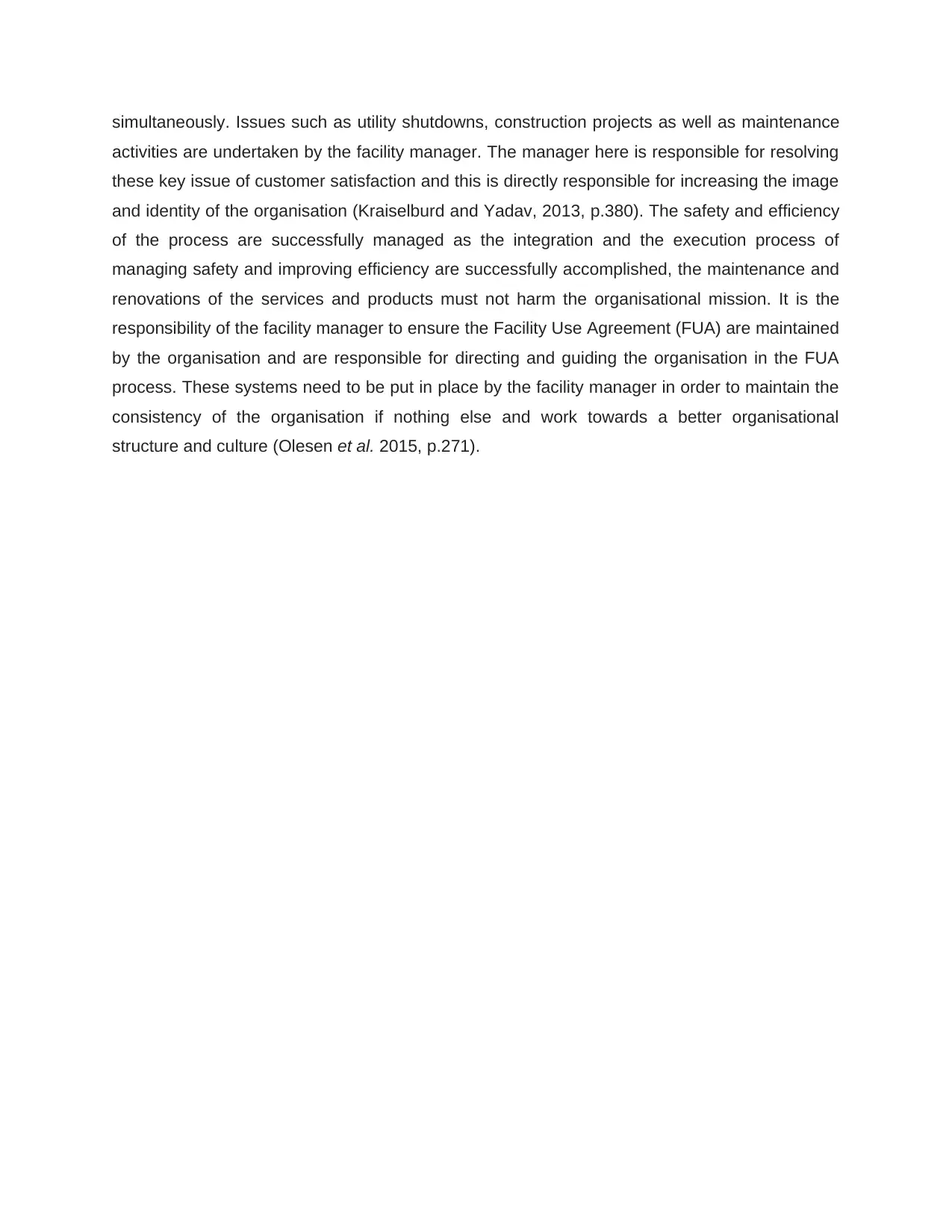
simultaneously. Issues such as utility shutdowns, construction projects as well as maintenance
activities are undertaken by the facility manager. The manager here is responsible for resolving
these key issue of customer satisfaction and this is directly responsible for increasing the image
and identity of the organisation (Kraiselburd and Yadav, 2013, p.380). The safety and efficiency
of the process are successfully managed as the integration and the execution process of
managing safety and improving efficiency are successfully accomplished, the maintenance and
renovations of the services and products must not harm the organisational mission. It is the
responsibility of the facility manager to ensure the Facility Use Agreement (FUA) are maintained
by the organisation and are responsible for directing and guiding the organisation in the FUA
process. These systems need to be put in place by the facility manager in order to maintain the
consistency of the organisation if nothing else and work towards a better organisational
structure and culture (Olesen et al. 2015, p.271).
activities are undertaken by the facility manager. The manager here is responsible for resolving
these key issue of customer satisfaction and this is directly responsible for increasing the image
and identity of the organisation (Kraiselburd and Yadav, 2013, p.380). The safety and efficiency
of the process are successfully managed as the integration and the execution process of
managing safety and improving efficiency are successfully accomplished, the maintenance and
renovations of the services and products must not harm the organisational mission. It is the
responsibility of the facility manager to ensure the Facility Use Agreement (FUA) are maintained
by the organisation and are responsible for directing and guiding the organisation in the FUA
process. These systems need to be put in place by the facility manager in order to maintain the
consistency of the organisation if nothing else and work towards a better organisational
structure and culture (Olesen et al. 2015, p.271).
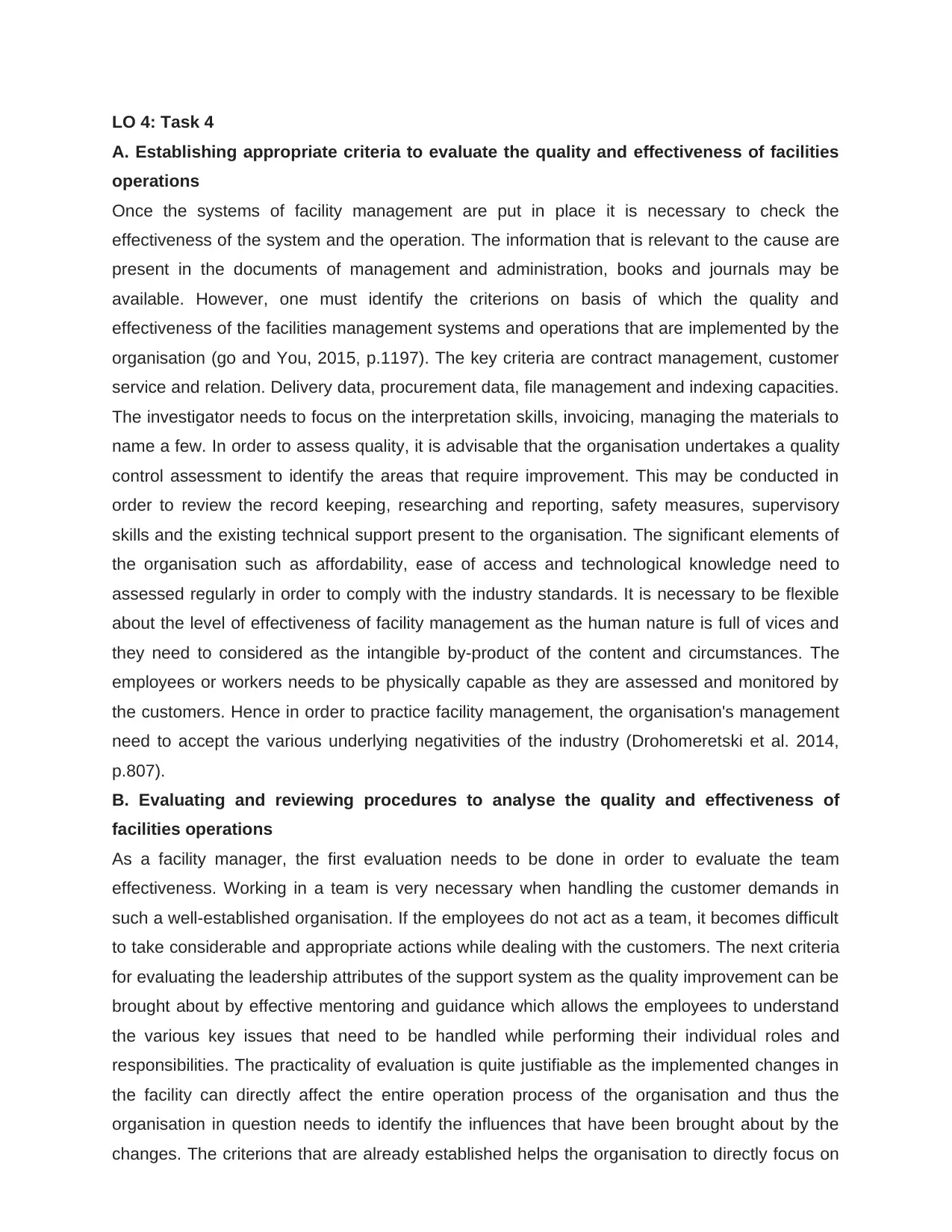
LO 4: Task 4
A. Establishing appropriate criteria to evaluate the quality and effectiveness of facilities
operations
Once the systems of facility management are put in place it is necessary to check the
effectiveness of the system and the operation. The information that is relevant to the cause are
present in the documents of management and administration, books and journals may be
available. However, one must identify the criterions on basis of which the quality and
effectiveness of the facilities management systems and operations that are implemented by the
organisation (go and You, 2015, p.1197). The key criteria are contract management, customer
service and relation. Delivery data, procurement data, file management and indexing capacities.
The investigator needs to focus on the interpretation skills, invoicing, managing the materials to
name a few. In order to assess quality, it is advisable that the organisation undertakes a quality
control assessment to identify the areas that require improvement. This may be conducted in
order to review the record keeping, researching and reporting, safety measures, supervisory
skills and the existing technical support present to the organisation. The significant elements of
the organisation such as affordability, ease of access and technological knowledge need to
assessed regularly in order to comply with the industry standards. It is necessary to be flexible
about the level of effectiveness of facility management as the human nature is full of vices and
they need to considered as the intangible by-product of the content and circumstances. The
employees or workers needs to be physically capable as they are assessed and monitored by
the customers. Hence in order to practice facility management, the organisation's management
need to accept the various underlying negativities of the industry (Drohomeretski et al. 2014,
p.807).
B. Evaluating and reviewing procedures to analyse the quality and effectiveness of
facilities operations
As a facility manager, the first evaluation needs to be done in order to evaluate the team
effectiveness. Working in a team is very necessary when handling the customer demands in
such a well-established organisation. If the employees do not act as a team, it becomes difficult
to take considerable and appropriate actions while dealing with the customers. The next criteria
for evaluating the leadership attributes of the support system as the quality improvement can be
brought about by effective mentoring and guidance which allows the employees to understand
the various key issues that need to be handled while performing their individual roles and
responsibilities. The practicality of evaluation is quite justifiable as the implemented changes in
the facility can directly affect the entire operation process of the organisation and thus the
organisation in question needs to identify the influences that have been brought about by the
changes. The criterions that are already established helps the organisation to directly focus on
A. Establishing appropriate criteria to evaluate the quality and effectiveness of facilities
operations
Once the systems of facility management are put in place it is necessary to check the
effectiveness of the system and the operation. The information that is relevant to the cause are
present in the documents of management and administration, books and journals may be
available. However, one must identify the criterions on basis of which the quality and
effectiveness of the facilities management systems and operations that are implemented by the
organisation (go and You, 2015, p.1197). The key criteria are contract management, customer
service and relation. Delivery data, procurement data, file management and indexing capacities.
The investigator needs to focus on the interpretation skills, invoicing, managing the materials to
name a few. In order to assess quality, it is advisable that the organisation undertakes a quality
control assessment to identify the areas that require improvement. This may be conducted in
order to review the record keeping, researching and reporting, safety measures, supervisory
skills and the existing technical support present to the organisation. The significant elements of
the organisation such as affordability, ease of access and technological knowledge need to
assessed regularly in order to comply with the industry standards. It is necessary to be flexible
about the level of effectiveness of facility management as the human nature is full of vices and
they need to considered as the intangible by-product of the content and circumstances. The
employees or workers needs to be physically capable as they are assessed and monitored by
the customers. Hence in order to practice facility management, the organisation's management
need to accept the various underlying negativities of the industry (Drohomeretski et al. 2014,
p.807).
B. Evaluating and reviewing procedures to analyse the quality and effectiveness of
facilities operations
As a facility manager, the first evaluation needs to be done in order to evaluate the team
effectiveness. Working in a team is very necessary when handling the customer demands in
such a well-established organisation. If the employees do not act as a team, it becomes difficult
to take considerable and appropriate actions while dealing with the customers. The next criteria
for evaluating the leadership attributes of the support system as the quality improvement can be
brought about by effective mentoring and guidance which allows the employees to understand
the various key issues that need to be handled while performing their individual roles and
responsibilities. The practicality of evaluation is quite justifiable as the implemented changes in
the facility can directly affect the entire operation process of the organisation and thus the
organisation in question needs to identify the influences that have been brought about by the
changes. The criterions that are already established helps the organisation to directly focus on
Secure Best Marks with AI Grader
Need help grading? Try our AI Grader for instant feedback on your assignments.
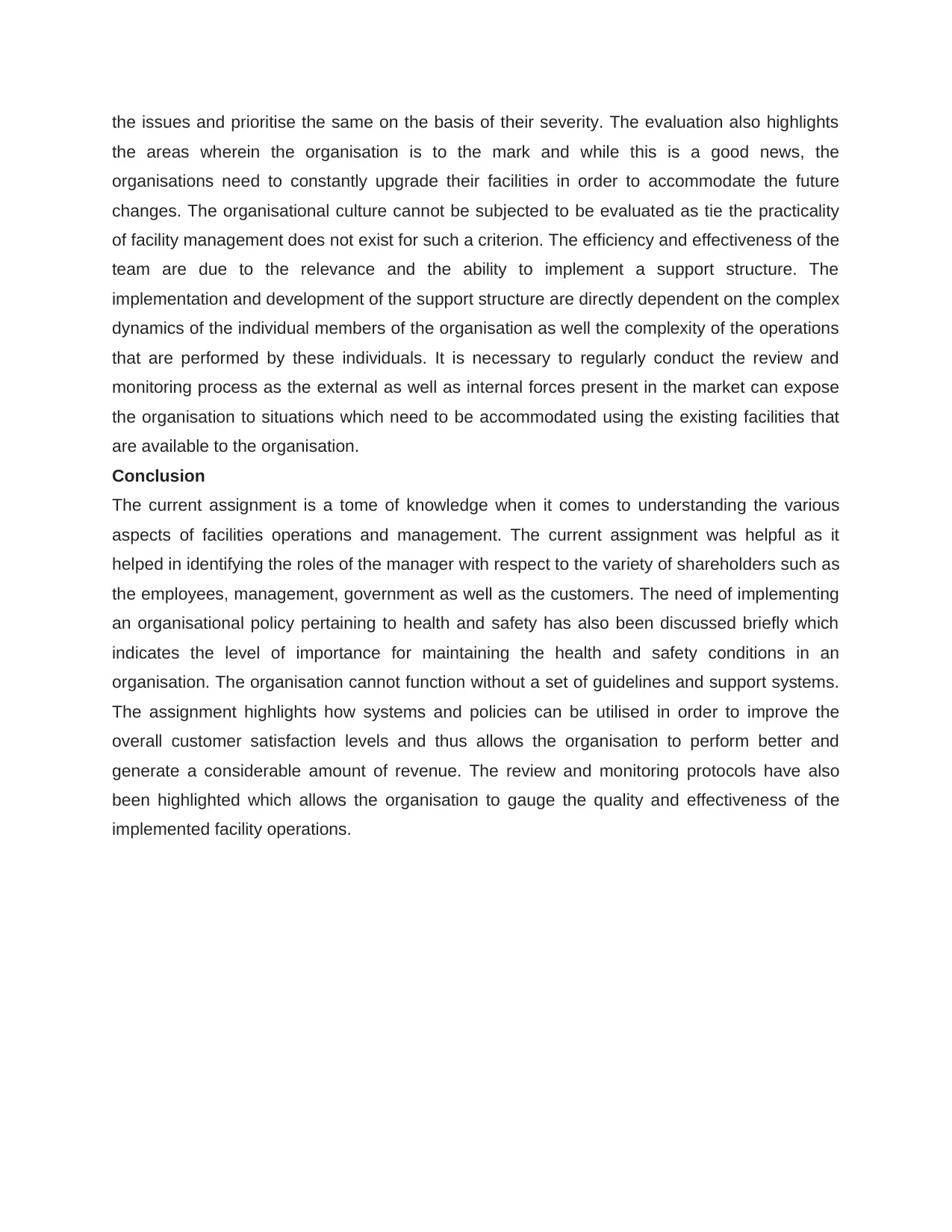
the issues and prioritise the same on the basis of their severity. The evaluation also highlights
the areas wherein the organisation is to the mark and while this is a good news, the
organisations need to constantly upgrade their facilities in order to accommodate the future
changes. The organisational culture cannot be subjected to be evaluated as tie the practicality
of facility management does not exist for such a criterion. The efficiency and effectiveness of the
team are due to the relevance and the ability to implement a support structure. The
implementation and development of the support structure are directly dependent on the complex
dynamics of the individual members of the organisation as well the complexity of the operations
that are performed by these individuals. It is necessary to regularly conduct the review and
monitoring process as the external as well as internal forces present in the market can expose
the organisation to situations which need to be accommodated using the existing facilities that
are available to the organisation.
Conclusion
The current assignment is a tome of knowledge when it comes to understanding the various
aspects of facilities operations and management. The current assignment was helpful as it
helped in identifying the roles of the manager with respect to the variety of shareholders such as
the employees, management, government as well as the customers. The need of implementing
an organisational policy pertaining to health and safety has also been discussed briefly which
indicates the level of importance for maintaining the health and safety conditions in an
organisation. The organisation cannot function without a set of guidelines and support systems.
The assignment highlights how systems and policies can be utilised in order to improve the
overall customer satisfaction levels and thus allows the organisation to perform better and
generate a considerable amount of revenue. The review and monitoring protocols have also
been highlighted which allows the organisation to gauge the quality and effectiveness of the
implemented facility operations.
the areas wherein the organisation is to the mark and while this is a good news, the
organisations need to constantly upgrade their facilities in order to accommodate the future
changes. The organisational culture cannot be subjected to be evaluated as tie the practicality
of facility management does not exist for such a criterion. The efficiency and effectiveness of the
team are due to the relevance and the ability to implement a support structure. The
implementation and development of the support structure are directly dependent on the complex
dynamics of the individual members of the organisation as well the complexity of the operations
that are performed by these individuals. It is necessary to regularly conduct the review and
monitoring process as the external as well as internal forces present in the market can expose
the organisation to situations which need to be accommodated using the existing facilities that
are available to the organisation.
Conclusion
The current assignment is a tome of knowledge when it comes to understanding the various
aspects of facilities operations and management. The current assignment was helpful as it
helped in identifying the roles of the manager with respect to the variety of shareholders such as
the employees, management, government as well as the customers. The need of implementing
an organisational policy pertaining to health and safety has also been discussed briefly which
indicates the level of importance for maintaining the health and safety conditions in an
organisation. The organisation cannot function without a set of guidelines and support systems.
The assignment highlights how systems and policies can be utilised in order to improve the
overall customer satisfaction levels and thus allows the organisation to perform better and
generate a considerable amount of revenue. The review and monitoring protocols have also
been highlighted which allows the organisation to gauge the quality and effectiveness of the
implemented facility operations.
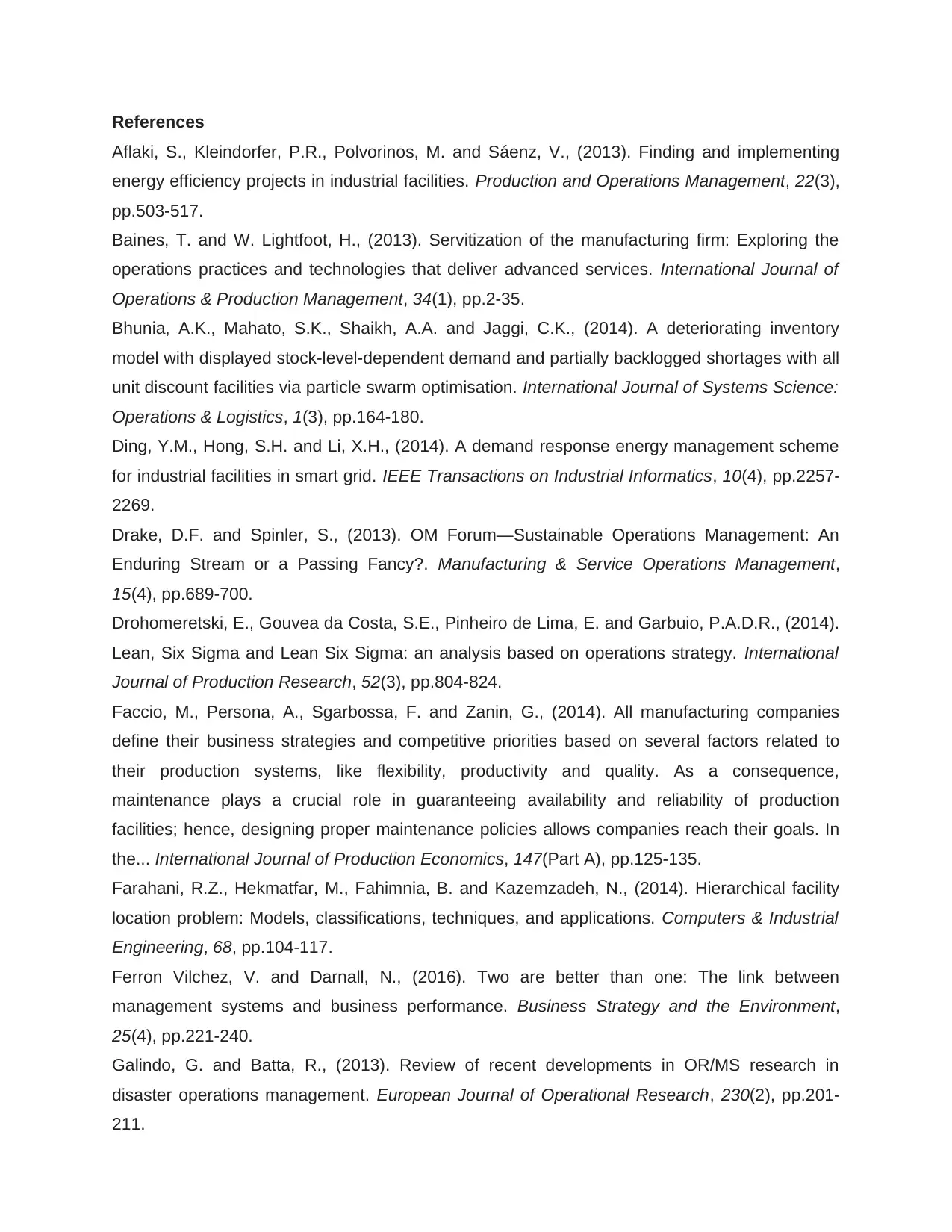
References
Aflaki, S., Kleindorfer, P.R., Polvorinos, M. and Sáenz, V., (2013). Finding and implementing
energy efficiency projects in industrial facilities. Production and Operations Management, 22(3),
pp.503-517.
Baines, T. and W. Lightfoot, H., (2013). Servitization of the manufacturing firm: Exploring the
operations practices and technologies that deliver advanced services. International Journal of
Operations & Production Management, 34(1), pp.2-35.
Bhunia, A.K., Mahato, S.K., Shaikh, A.A. and Jaggi, C.K., (2014). A deteriorating inventory
model with displayed stock-level-dependent demand and partially backlogged shortages with all
unit discount facilities via particle swarm optimisation. International Journal of Systems Science:
Operations & Logistics, 1(3), pp.164-180.
Ding, Y.M., Hong, S.H. and Li, X.H., (2014). A demand response energy management scheme
for industrial facilities in smart grid. IEEE Transactions on Industrial Informatics, 10(4), pp.2257-
2269.
Drake, D.F. and Spinler, S., (2013). OM Forum—Sustainable Operations Management: An
Enduring Stream or a Passing Fancy?. Manufacturing & Service Operations Management,
15(4), pp.689-700.
Drohomeretski, E., Gouvea da Costa, S.E., Pinheiro de Lima, E. and Garbuio, P.A.D.R., (2014).
Lean, Six Sigma and Lean Six Sigma: an analysis based on operations strategy. International
Journal of Production Research, 52(3), pp.804-824.
Faccio, M., Persona, A., Sgarbossa, F. and Zanin, G., (2014). All manufacturing companies
define their business strategies and competitive priorities based on several factors related to
their production systems, like flexibility, productivity and quality. As a consequence,
maintenance plays a crucial role in guaranteeing availability and reliability of production
facilities; hence, designing proper maintenance policies allows companies reach their goals. In
the... International Journal of Production Economics, 147(Part A), pp.125-135.
Farahani, R.Z., Hekmatfar, M., Fahimnia, B. and Kazemzadeh, N., (2014). Hierarchical facility
location problem: Models, classifications, techniques, and applications. Computers & Industrial
Engineering, 68, pp.104-117.
Ferron Vilchez, V. and Darnall, N., (2016). Two are better than one: The link between
management systems and business performance. Business Strategy and the Environment,
25(4), pp.221-240.
Galindo, G. and Batta, R., (2013). Review of recent developments in OR/MS research in
disaster operations management. European Journal of Operational Research, 230(2), pp.201-
211.
Aflaki, S., Kleindorfer, P.R., Polvorinos, M. and Sáenz, V., (2013). Finding and implementing
energy efficiency projects in industrial facilities. Production and Operations Management, 22(3),
pp.503-517.
Baines, T. and W. Lightfoot, H., (2013). Servitization of the manufacturing firm: Exploring the
operations practices and technologies that deliver advanced services. International Journal of
Operations & Production Management, 34(1), pp.2-35.
Bhunia, A.K., Mahato, S.K., Shaikh, A.A. and Jaggi, C.K., (2014). A deteriorating inventory
model with displayed stock-level-dependent demand and partially backlogged shortages with all
unit discount facilities via particle swarm optimisation. International Journal of Systems Science:
Operations & Logistics, 1(3), pp.164-180.
Ding, Y.M., Hong, S.H. and Li, X.H., (2014). A demand response energy management scheme
for industrial facilities in smart grid. IEEE Transactions on Industrial Informatics, 10(4), pp.2257-
2269.
Drake, D.F. and Spinler, S., (2013). OM Forum—Sustainable Operations Management: An
Enduring Stream or a Passing Fancy?. Manufacturing & Service Operations Management,
15(4), pp.689-700.
Drohomeretski, E., Gouvea da Costa, S.E., Pinheiro de Lima, E. and Garbuio, P.A.D.R., (2014).
Lean, Six Sigma and Lean Six Sigma: an analysis based on operations strategy. International
Journal of Production Research, 52(3), pp.804-824.
Faccio, M., Persona, A., Sgarbossa, F. and Zanin, G., (2014). All manufacturing companies
define their business strategies and competitive priorities based on several factors related to
their production systems, like flexibility, productivity and quality. As a consequence,
maintenance plays a crucial role in guaranteeing availability and reliability of production
facilities; hence, designing proper maintenance policies allows companies reach their goals. In
the... International Journal of Production Economics, 147(Part A), pp.125-135.
Farahani, R.Z., Hekmatfar, M., Fahimnia, B. and Kazemzadeh, N., (2014). Hierarchical facility
location problem: Models, classifications, techniques, and applications. Computers & Industrial
Engineering, 68, pp.104-117.
Ferron Vilchez, V. and Darnall, N., (2016). Two are better than one: The link between
management systems and business performance. Business Strategy and the Environment,
25(4), pp.221-240.
Galindo, G. and Batta, R., (2013). Review of recent developments in OR/MS research in
disaster operations management. European Journal of Operational Research, 230(2), pp.201-
211.
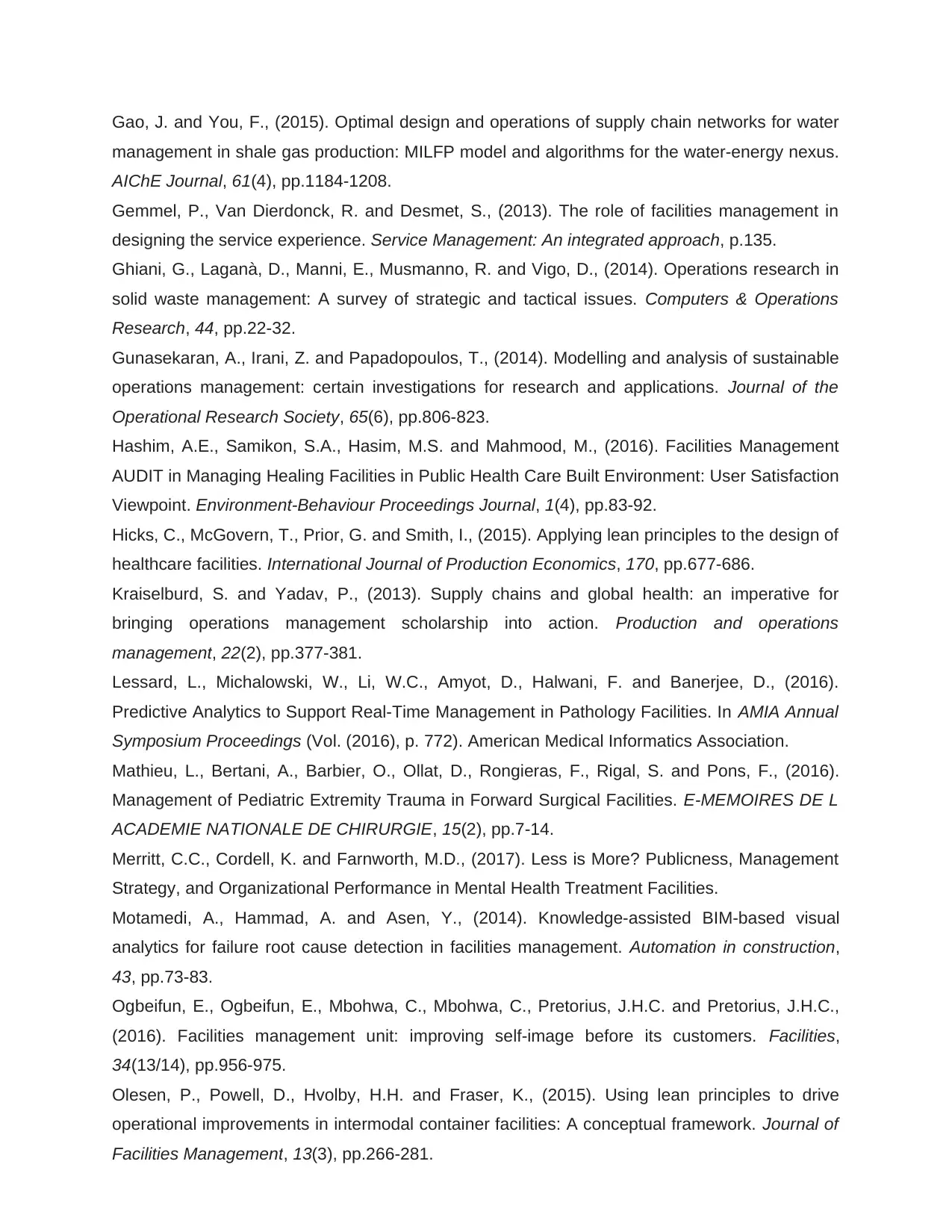
Gao, J. and You, F., (2015). Optimal design and operations of supply chain networks for water
management in shale gas production: MILFP model and algorithms for the water‐energy nexus.
AIChE Journal, 61(4), pp.1184-1208.
Gemmel, P., Van Dierdonck, R. and Desmet, S., (2013). The role of facilities management in
designing the service experience. Service Management: An integrated approach, p.135.
Ghiani, G., Laganà, D., Manni, E., Musmanno, R. and Vigo, D., (2014). Operations research in
solid waste management: A survey of strategic and tactical issues. Computers & Operations
Research, 44, pp.22-32.
Gunasekaran, A., Irani, Z. and Papadopoulos, T., (2014). Modelling and analysis of sustainable
operations management: certain investigations for research and applications. Journal of the
Operational Research Society, 65(6), pp.806-823.
Hashim, A.E., Samikon, S.A., Hasim, M.S. and Mahmood, M., (2016). Facilities Management
AUDIT in Managing Healing Facilities in Public Health Care Built Environment: User Satisfaction
Viewpoint. Environment-Behaviour Proceedings Journal, 1(4), pp.83-92.
Hicks, C., McGovern, T., Prior, G. and Smith, I., (2015). Applying lean principles to the design of
healthcare facilities. International Journal of Production Economics, 170, pp.677-686.
Kraiselburd, S. and Yadav, P., (2013). Supply chains and global health: an imperative for
bringing operations management scholarship into action. Production and operations
management, 22(2), pp.377-381.
Lessard, L., Michalowski, W., Li, W.C., Amyot, D., Halwani, F. and Banerjee, D., (2016).
Predictive Analytics to Support Real-Time Management in Pathology Facilities. In AMIA Annual
Symposium Proceedings (Vol. (2016), p. 772). American Medical Informatics Association.
Mathieu, L., Bertani, A., Barbier, O., Ollat, D., Rongieras, F., Rigal, S. and Pons, F., (2016).
Management of Pediatric Extremity Trauma in Forward Surgical Facilities. E-MEMOIRES DE L
ACADEMIE NATIONALE DE CHIRURGIE, 15(2), pp.7-14.
Merritt, C.C., Cordell, K. and Farnworth, M.D., (2017). Less is More? Publicness, Management
Strategy, and Organizational Performance in Mental Health Treatment Facilities.
Motamedi, A., Hammad, A. and Asen, Y., (2014). Knowledge-assisted BIM-based visual
analytics for failure root cause detection in facilities management. Automation in construction,
43, pp.73-83.
Ogbeifun, E., Ogbeifun, E., Mbohwa, C., Mbohwa, C., Pretorius, J.H.C. and Pretorius, J.H.C.,
(2016). Facilities management unit: improving self-image before its customers. Facilities,
34(13/14), pp.956-975.
Olesen, P., Powell, D., Hvolby, H.H. and Fraser, K., (2015). Using lean principles to drive
operational improvements in intermodal container facilities: A conceptual framework. Journal of
Facilities Management, 13(3), pp.266-281.
management in shale gas production: MILFP model and algorithms for the water‐energy nexus.
AIChE Journal, 61(4), pp.1184-1208.
Gemmel, P., Van Dierdonck, R. and Desmet, S., (2013). The role of facilities management in
designing the service experience. Service Management: An integrated approach, p.135.
Ghiani, G., Laganà, D., Manni, E., Musmanno, R. and Vigo, D., (2014). Operations research in
solid waste management: A survey of strategic and tactical issues. Computers & Operations
Research, 44, pp.22-32.
Gunasekaran, A., Irani, Z. and Papadopoulos, T., (2014). Modelling and analysis of sustainable
operations management: certain investigations for research and applications. Journal of the
Operational Research Society, 65(6), pp.806-823.
Hashim, A.E., Samikon, S.A., Hasim, M.S. and Mahmood, M., (2016). Facilities Management
AUDIT in Managing Healing Facilities in Public Health Care Built Environment: User Satisfaction
Viewpoint. Environment-Behaviour Proceedings Journal, 1(4), pp.83-92.
Hicks, C., McGovern, T., Prior, G. and Smith, I., (2015). Applying lean principles to the design of
healthcare facilities. International Journal of Production Economics, 170, pp.677-686.
Kraiselburd, S. and Yadav, P., (2013). Supply chains and global health: an imperative for
bringing operations management scholarship into action. Production and operations
management, 22(2), pp.377-381.
Lessard, L., Michalowski, W., Li, W.C., Amyot, D., Halwani, F. and Banerjee, D., (2016).
Predictive Analytics to Support Real-Time Management in Pathology Facilities. In AMIA Annual
Symposium Proceedings (Vol. (2016), p. 772). American Medical Informatics Association.
Mathieu, L., Bertani, A., Barbier, O., Ollat, D., Rongieras, F., Rigal, S. and Pons, F., (2016).
Management of Pediatric Extremity Trauma in Forward Surgical Facilities. E-MEMOIRES DE L
ACADEMIE NATIONALE DE CHIRURGIE, 15(2), pp.7-14.
Merritt, C.C., Cordell, K. and Farnworth, M.D., (2017). Less is More? Publicness, Management
Strategy, and Organizational Performance in Mental Health Treatment Facilities.
Motamedi, A., Hammad, A. and Asen, Y., (2014). Knowledge-assisted BIM-based visual
analytics for failure root cause detection in facilities management. Automation in construction,
43, pp.73-83.
Ogbeifun, E., Ogbeifun, E., Mbohwa, C., Mbohwa, C., Pretorius, J.H.C. and Pretorius, J.H.C.,
(2016). Facilities management unit: improving self-image before its customers. Facilities,
34(13/14), pp.956-975.
Olesen, P., Powell, D., Hvolby, H.H. and Fraser, K., (2015). Using lean principles to drive
operational improvements in intermodal container facilities: A conceptual framework. Journal of
Facilities Management, 13(3), pp.266-281.
Paraphrase This Document
Need a fresh take? Get an instant paraphrase of this document with our AI Paraphraser
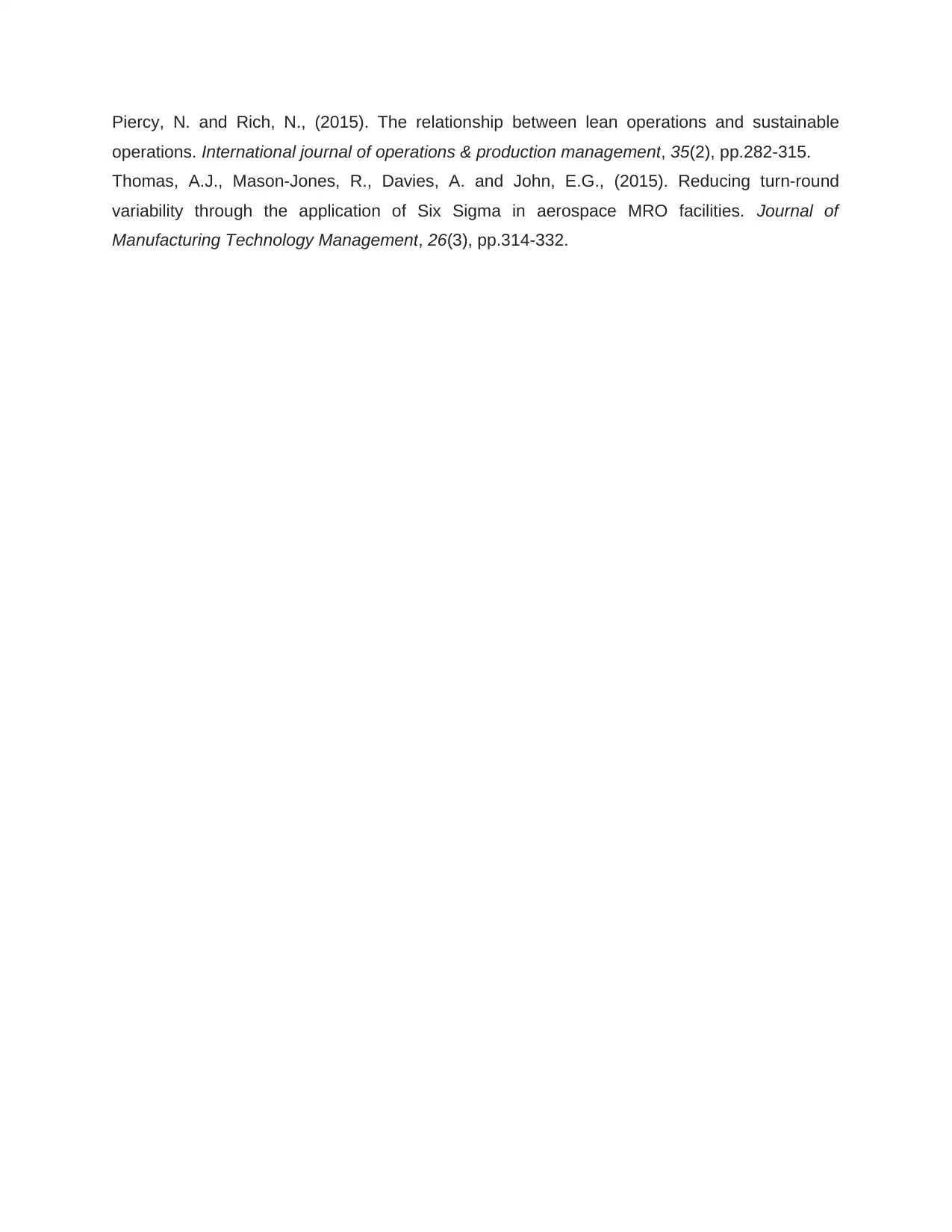
Piercy, N. and Rich, N., (2015). The relationship between lean operations and sustainable
operations. International journal of operations & production management, 35(2), pp.282-315.
Thomas, A.J., Mason-Jones, R., Davies, A. and John, E.G., (2015). Reducing turn-round
variability through the application of Six Sigma in aerospace MRO facilities. Journal of
Manufacturing Technology Management, 26(3), pp.314-332.
operations. International journal of operations & production management, 35(2), pp.282-315.
Thomas, A.J., Mason-Jones, R., Davies, A. and John, E.G., (2015). Reducing turn-round
variability through the application of Six Sigma in aerospace MRO facilities. Journal of
Manufacturing Technology Management, 26(3), pp.314-332.
1 out of 14
Related Documents
Your All-in-One AI-Powered Toolkit for Academic Success.
+13062052269
info@desklib.com
Available 24*7 on WhatsApp / Email
![[object Object]](/_next/static/media/star-bottom.7253800d.svg)
Unlock your academic potential
© 2024 | Zucol Services PVT LTD | All rights reserved.





